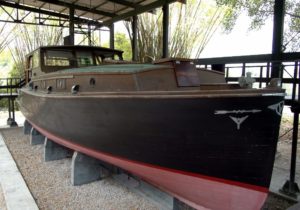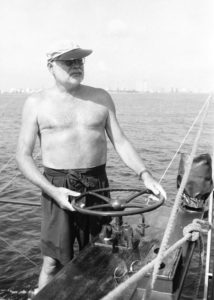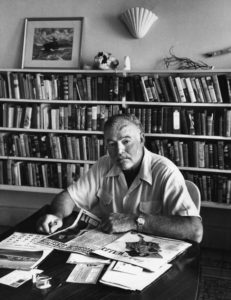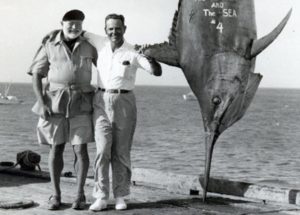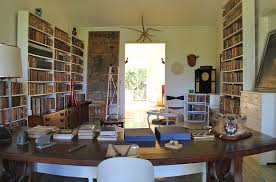 UN HOMBRE LLAMADO ERNEST HEMINGWAY BURLA EL EMBARGO A CUBA.
UN HOMBRE LLAMADO ERNEST HEMINGWAY BURLA EL EMBARGO A CUBA.
Ahora que Estados Unidos recrudece el embargo contra Cuba y amenaza con activar la ley Helms-Burton, de nuevo la figura de Ernest Hemingway y su legado sirven para tender puentes entre ambos países y unir lo que Donald Trump separa. El punto de encuentro otra vez es Finca Vigía, la vieja casona que el escritor estadounidense habitó a las afueras de La Habana desde 1940 hasta su muerte, en 1961, cuando su viuda, Mary Welsh, la donó al gobierno cubano, que la convirtió en el Museo Hemingway.
Desde entonces, Finca Vigía ha sido lugar de peregrinación para decenas de miles de estadounidenses llegados a la isla de diversos modos, muchos violando las leyes del embargo. La casa donde el novelista escribió en 1952 El viejo y el mar y donde recibió la noticia del Premio Nobel dos años después, ya fue en momentos de máxima tensión entre Washington y La Habana un territorio neutral donde instituciones de ambos países pudieron cooperar. En 2002, cuando el expresidente George W. Bush bombardeaba Afganistán y endurecía las sanciones a Cuba, se firmó el primer acuerdo de colaboración entre las autoridades cubanas y la Fundación Finca Vigía, de EE UU, para preservar el mundo de Hemingway en Cuba.
Primero se restauró la casa y también el yate Pilar, en el que el escritor salía a pescar a la corriente del Golfo. La colaboración se amplió después, se firmaron convenios con el Consejo de las Ciencias Sociales de EE UU para digitalizar miles de documentos y que estos pudieran consultarse en la biblioteca Kennedy de Boston, y se trabó una tupida red de donantes en EE UU, todo esto mientras caían chuzos en las relaciones bilaterales. Así hasta el pasado fin de semana, cuando después de dos años y medio de trabajo se inauguró en Finca Vigía un moderno centro con un laboratorio de restauración y una bóveda para almacenar la valiosa documentación en las mejores condiciones.
Para enviar los cinco contenedores que transportaron los equipos y suministros desde EE UU, la Fundación Finca Vigía tuvo que sortear numerosas restricciones impuestas por el embargo y la administración Trump. “Este edificio es símbolo de lo que se puede lograr cuando personas buenas trabajan juntas. Esperamos que sea un modelo de lo que se puede esperar en el futuro del esfuerzo común entre cubanos y estadounidenses”, dijo la directora de la Fundación, Mary Jo Adams. El proyecto se realizó gracias a donaciones de compañías como American Express, AT&T o Caterpillar, además de la Fundación Ford y los nietos de Max Perkins, editor de Hemingway.
“Cuando Hemingway murió, en 1961, habían pasado solo tres meses del desastre de Bahía de Cochinos; las relaciones entre Cuba y EE UU estaban en su punto más bajo. La única hebra de civilidad en ese momento entre ambos países la aportó su legado”, señaló el congresista estadounidense James McGovern, presente en la ceremonia de apertura. “Esperaba que la situación entre Cuba y EE UU a estas alturas estuviese en un mejor momento”, comentó. “Lamentablemente, tenemos una nueva administración que está dando marcha atrás en la política de acercamiento, prefiriendo la confrontación en lugar del compromiso. Aparentemente existe nostalgia por el periodo de Guerra Fría”, añadió.
En Finca Vigía se guardan miles de documentos y cartas, incluidos manuscritos de algunas de las obras del Premio Nobel —como un epílogo de Por quién doblan las campanas distinto al que se publicó—, el guion de la película El viejo y el mar, interpretada por Spencer Tracy, sobre el que Hemingway hizo críticas a algunas secuencias y corrigió o amplió diálogos. También más de 3.000 fotografías, 9.000 libros y revistas —cerca de 2.000 subrayados o con notas al margen—, el pasaporte que empleó durante la Guerra Civil española o los códigos para descifrar los mensajes en clave que Hemingway enviaba desde el Pilar durante la rocambolesca operación de persecución de submarinos nazis que protagonizó en los cayos de la isla en la II Guerra Mundial.
En Finca Vigía se conserva la vieja máquina de escribir Underwood del escritor, sus trofeos de caza, la botella de whisky medio llena y el disco de Glenn Miller que dejó en el gramófono antes de partir. En el baño, pegado al inodoro, en un pequeño librero se puede encontrar todo tipo de literatura —incluida una biografía del ilusionista Houdini— y también queda una vieja pesa. En la pared están las anotaciones de su peso, que controlaba a diario. Las marcas de 1955 muestran al Hemingway más conocido, modelo oso: “14 de abril. 240 libras [109 kilos]”. La última anotación es de un día antes de partir para no regresar más: “24 de julio de 1960. 190 libras [86 kilos]”. Ya padecía la enfermedad que un año después provocó su suicidio. Con la apertura impulsada por el presidente Obama, miles de compatriotas viajaron a Cuba y peregrinaron a Finca Vigía para sumergirse en el mundo de Hemingway. Con Trump las visitas han caído en picado.
La copiosa correspondencia que se almacena incluye cartas, telegramas y postales. No tiene desperdicio. En mayo de 1956, le escribe un admirador desde Calella, en Cataluña, lamentándose por “no poder leer Por quién doblan las campanas por no estar autorizada su venta en España”, si bien le advierte de que está “muy lejos de compartir su incomprensible pasión por la bebida”. Hay solicitudes de todo tipo: en 1943, la Unión de Escritores Soviéticos le pide que envíe copia de sus discursos antifascistas para colaborar con la lucha contra el “vandalismo nazi”, y un amigo le ruega desde México que interceda para que un jugador español de jai alai pueda entrar a EE UU, vetado por supuestos vínculos con la Falange.
Entre las fotos también hay maravillas, muchas con sus amigos de Hollywood, como Spencer Tracy o Ava Gardner, a quien solía invitar al bar Floridita a beber daiquiris preparados por el barman catalán Constante. También se guardan entrevistas, como en la que Hemingway confiesa: “Uno vive en esta isla porque para ir a la ciudad no hace falta más que ponerse los zapatos, porque se puede tapar con papel el timbre del teléfono para evitar cualquier llamada, y porque en el fresco de la mañana se trabaja mejor y con más comodidad que en cualquier otro sitio. Pero esto es un secreto profesional”.
Mientras este jueves Trump amenazaba con activar en 15 días el título III de la ley Helms Burton, que permitiría a ciudadanos cubanoamericanos reclamar ante tribunales de EE UU propiedades expropiadas por la revolución y sancionar a empresas que “trafiquen” con ellas, en Finca Vigía comenzaba una nueva etapa de trabajo. Con los escáner y equipos de alta tecnología del nuevo laboratorio, documentos de alto valor, como el cuaderno de bitácora del Pilar, en el que Hemingway registró el peso y tamaño del último pez espada que capturó y describió el último temporal al que se enfrentó en el mar, cobrarán nueva vida.
 A MAN CALLED ERNEST HEMINGWAY GIBE THE EMBARGO TO CUBA.
A MAN CALLED ERNEST HEMINGWAY GIBE THE EMBARGO TO CUBA.
Now that the United States intensifies the embargo against Cuba and threatens to activate the Helms-Burton law, again the figure of Ernest Hemingway and his legacy serve to build bridges between both countries and unite what Donald Trump separates. The meeting point again is Finca Vigía, the old house that the American writer inhabited the outskirts of Havana from 1940 until his death, in 1961, when his widow, Mary Welsh, donated it to the Cuban government, which turned it into The Hemingway Museum.
Since then, Finca Vigía has been a place of pilgrimage for tens of thousands of Americans who have come to the island in various ways, many violating the embargo laws. The house where the novelist wrote in 1952 El viejo y el mar and where he received the news of the Nobel Prize two years later, was already at moments of maximum tension between Washington and Havana a neutral territory where institutions of both countries could cooperate. In 2002, when former president George W. Bush bombed Afghanistan and toughened sanctions on Cuba, the first collaboration agreement between the Cuban authorities and the Finca Vigia Foundation of the United States was signed to preserve the Hemingway world in Cuba.
First, the house was restored and also the Pilar yacht, in which the writer went fishing in the Gulf Stream. The collaboration was extended later, agreements were signed with the Council of Social Sciences of the USA to digitize thousands of documents and that these could be consulted in the Kennedy Library in Boston, and a dense network of donors was established in the US, all this while pikes were falling in bilateral relations. So until last weekend, when after two and a half years of work was inaugurated in Finca Vigía a modern center with a restoration laboratory and a vault to store the valuable documentation in the best conditions.
To send the five containers that transported the equipment and supplies from the United States, the Finca Vigía Foundation had to overcome numerous restrictions imposed by the embargo and the Trump administration. “This building is a symbol of what can be achieved when good people work together. We hope it will be a model of what can be expected in the future of the common effort between Cubans and Americans, “said Foundation Director Mary Jo Adams. The project was made thanks to donations from companies such as American Express, AT & T or Caterpillar, as well as the Ford Foundation and the grandchildren of Max Perkins, editor of Hemingway.
“When Hemingway died, in 1961, only three months had passed since the Bay of Pigs disaster; relations between Cuba and the United States were at their lowest point. The only strand of civility at that time between both countries was provided by his legacy, “said US Congressman James McGovern, present at the opening ceremony. “I was hoping that the situation between Cuba and the US at this point was at a better time,” he said. “Regrettably, we have a new administration that is backtracking on the policy of rapprochement, preferring confrontation instead of compromise. Apparently, there is nostalgia for the Cold War period, “he added.
At Finca Vigía, thousands of documents and letters are kept, including manuscripts of some of the works of the Nobel Prize -like an epilogue of For Whom the Bell Tolls, different from the one published-, the script of the film El viejo y el mar, interpreted by Spencer Tracy, on which Hemingway criticized some sequences and corrected or extended dialogues. Also more than 3,000 photographs, 9,000 books and magazines -about 2,000 underlining or with marginal notes-, the passport used during the Spanish Civil War or the codes to decipher the key messages that Hemingway sent from the Pilar during the bizarre operation of pursuit of Nazi submarines that starred in the keys of the island in World War II.
At Finca Vigía, the writer’s old Underwood typewriter, his hunting trophies, the half-full whiskey bottle and the Glenn Miller record he left on the gramophone before leaving are preserved. In the bathroom, close to the toilet, in a small bookcase, you can find all kinds of literature -including a biography of the illusionist Houdini- and there is also an old weight. On the wall are the notes of his weight, which he controlled daily. The 1955 marks show the best known Hemingway, bear model: “April 14. 240 pounds [109 kilos] “. The last entry is one day before leaving to not return anymore: “July 24, 1960. 190 pounds [86 kilos]”. He already suffered from the disease than a year later caused his suicide. With the opening promoted by President Obama, thousands of compatriots traveled to Cuba and made a pilgrimage to Finca Vigía to immerse themselves in the world of Hemingway. With Trump, the visits have plummeted.
The copious correspondence that is stored includes letters, telegrams, and postcards. It has no waste. In May 1956, he writes an admirer from Calella, in Catalonia, lamenting for “not being able to read For whom the bell tolls for not being authorized for sale in Spain”, although he warns that he is “very far from sharing his incomprehensible passion for a drink “. There are requests of all kinds: in 1943, the Union of Soviet Writers asks him to send a copy of his anti-fascist speeches to help fight the “Nazi vandalism”, and a friend begs him from Mexico to intercede so that a Spanish player jai alai can enter the US, vetoed by alleged links with the Falange.
Among the photos, there are also wonders, many with his friends from Hollywood, such as Spencer Tracy or Ava Gardner, whom he used to invite to the Floridita bar to drink daiquiris prepared by the Catalan bartender Constante. Interviews are also kept, as in which Hemingway confesses: “You live on this island because to go to the city you only have to put on your shoes, because you can cover the phone with paper to avoid any call, and because In the cool of the morning you work better and more comfortable than anywhere else. But this is a professional secret. ”
While this Thursday Trump threatened to activate in 15 days the title III of the Helms-Burton law, which would allow Cuban-American citizens to claim before US courts properties expropriated by the revolution and sanction companies that “traffic” with them, at Finca Vigía began a new stage of work. With the scanners and high-tech equipment of the new laboratory, high-value documents, such as the Pilar logbook, in which Hemingway recorded the weight and size of the last swordfish he captured and described the last storm he faced in the sea, they will take on new life.
Agencies/ El País/ Mauricio Vicent,La Habana/ Internet Photos/ Arnoldo Varona/ www.TheCubanhistory.com
THE CUBAN HISTORY, HOLLYWOOD.



 < A MAN CALLED Ernest Hemingway Gibe the Embargo to Cuba.
< A MAN CALLED Ernest Hemingway Gibe the Embargo to Cuba.